

Haiku #301: by Sharon Dean
First Published: The Dreaming Collection, 2009
kelpie
The Australian Working Kelpie is a sheep dog capable of tirelessly working in blistering heat, freezing cold and over great distances for days on end,
a good kelpie is said to be worth many men, particulary in mountain conditions or over vast areas.
Flame Tree
Illawarra Flame Tree
(Brachychiton acerifolius), is a large tree native to subtropical regions on the east coast of Australia.
Along with other members of the Brachychiton genus, it is commonly referred to as a Kurrajong.
Haiku #303: by Neil Bramsen
First Published: The Dreaming Collection, 2009
CRICKET
How to briefly explain the sport of 'cricket' to anybody who hasn't grown up playing it in the backyard or street? WikipediA makes a good effort but it isn't brief.
Referring to this haiku:Cricket is often played by friends and family on the beach at low tide.
Haiku #: by
First Published: The Dreaming Collection, 2009

Haiku #305: by Tony Beyer
First Published: The Dreaming Collection, 2009
CRICKET
How to briefly explain the sport of 'cricket' to anybody who hasn't grown up playing it in the backyard or street? WikipediA makes a good effort but it isn't brief.
Referring to this haiku:A SIGHT SCREEN is the large, usually white, screen placed at both ends of the ground so that the batsman can clearly see the ball as it is delivered by the bowler.
GALAH - the common, noisy, pink and white Australian parrot; they often move in large flocks.
Haiku #306: by Kirsten Cliff
First Published: The Dreaming Collection, 2009
Haiku #307: by Lorraine Haig
First Published: The Dreaming Collection, 2009
Haiku #308: by Barbara Strang
First Published: The Dreaming Collection, 2009
Haiku #309: by Bett Angel-Stawarz
First Published: The Dreaming Collection, 2009
Haiku #310: by Vanessa Proctor
First Published: The Dreaming Collection, 2009
Haiku #311: by Roberta Beary
First Published: The Dreaming Collection, 2009
BOOMERANG
Wikepedia: "A boomerang is a curved piece of wood used as a weapon and for sport. Boomerangs come in many shapes and sizes depending on their geographic or tribal origins and intended function. The most recognizable type is the returning boomerang, which is a throwing stick that travels in a elliptical path and returns to its point of origin when thrown correctly. Although non-returning boomerangs (throw sticks or kylies) were used as weapons, returning boomerangs have been used primarily for leisure or recreation."
Haiku #312: by Sharon Dean
First Published: The Dreaming Collection, 2009
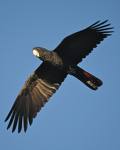
The Red-tailed Black Cockatoo (Calyptorhynchus banksii) is a large cockatoo native to Australia
Haiku #313: by Norma Watts
First Published: The Dreaming Collection, 2009
a Southern Stingray
Haiku #:
First Published: The Dreaming Collection, 2009
Haiku #315: by Quendryth Young
First Published: The Dreaming Collection, 2009
Billabong
"A billabong ('bill-a-bong') is a body of water, like a large pond."
"A billabong forms when a river changes its course, leaving a section cut off from the new river. When the river floods every wet season, the water in the billabong flows again as it connects up with the main river. Because of this the water stays fresh and supports an abundance of life." more from Questacon
Haiku #316: by Jan O'Loughlin
First Published: The Dreaming Collection, 2009
Haiku #317: by Neil Bramsen
First Published: The Dreaming Collection

Wombats are stout, sturdy marsupials. They grow to about 1.3 metres in length,
and can weigh up to 36 kg. They have a large, blunt head with small eyes and ears,
and a short, muscular neck. Their sharp claws and stubby, powerful legs make them great diggers.
Haiku #318: by Gavin Austin
First Published: The Dreaming Collection, 2009
[details later]
Haiku #319: by Patricia Prime
First Published: The Dreaming Collection, 2009
Haiku #320: by Andre Surridge
First Published: The Dreaming Collection, 2009

a rugby scrum, night game
Haiku #321: by Katherine Gallagher
First Published: The Dreaming Collection, 2009
Haiku #322: by Roberta Beary
First Published: The Dreaming Collection, 2009
Irish Australians
Irish emigration to Australia began with the transportation of 40,000 Irish convicts. Many were deported for political activity such as participation in the Irish Rebellion of 1798. When convict transportation ceased in 1868 the inflow continued but as 'free settlers.' Today Irish Australians are the third largest ethnic group in Australia, after Australian and English.
Haiku #323: by Lyn Reeves
First Published: The Dreaming Collection, 2009
The Casuarinaceae family is native to Australia, southeast Asia and islands of the Pacific.
Casuarinas are commonly known as 'she oaks', sometimes as 'swamp oaks' because their wood resembles that of oak.
Casuarinas are often called “native or Australian pines” because their foliage bears a similarity to pine needles.
The word 'casuarina' derives from the word 'cassowary' - she oaks are characterised by their fine, textured evergreen foliage, that looks like the feathers on the bird.
Like pine trees, she oaks have little cones full of seeds that attract black cockatoos, finches and rainbow lorikeets. Willie Wagtails, Pee Wees and Butcher birds all favour she oaks for nesting trees. The foliage of she oaks creates a wonderful whistling sound when the wind blows through them..
Haiku #324: by Nathalie Buckland
First Published: The Dreaming Collection, 2009
Haiku #325: by Angela Smith
First Published: The Dreaming Collection, 2009
Haiku #326: by Dane Smith
First Published: The Dreaming Collection, 2009
Haiku #327: by Vanessa Proctor
First Published: The Dreaming Collection, 2009
Haiku #328: by Jan Iwaszkiewicz
First Published: The Dreaming Collection, 2009
Haiku #329: by Barbara Taylor
First Published: Haiku World Shiki, July 2009
Haiku #330: by Barbara Taylor
First Published: riverbed, April 2009
Haiku #331: by Barbara Taylor
First Published: asahi haiku, January 2009
[Editor: the context suggests a festive celebration such as New Year, and a location such as under the Sydney Harbour Bridge, a vantage point for watching fireworks.]
Haiku #332: by Ron Moss
First Published: Final Words Haiku Competition, 2009
Haiku #333: by Rob Scott
First Published: paper wasp 11 (2) autumn 2005
[yellow box pic later]
Haiku #344: by Maureen Sexton
First Published: later
[details re grevillea later]
Haiku #335: by Janice M Bostok
First Published: Amongst The Graffiti, , Janice M. Bostok, 2003
The Pied Currawong is a large, mostly black bird, with a bright yellow eye.
Small patches of white are confined to the under tail, the tips and bases of the tail feathers
and a small patch towards the tip of each wing (visible in flight).
It is found throughout eastern Australia except for Tasmania.
Two other species of currawong are found in Australia.
The Grey Currawong, lives in Australia's south, while the Black Currawong is restricted to Tasmania.
Both of these species differ from the Pied Currawong in lacking white on the rump
The Pied Currawong prefers forests and woodlands, and has become well adapted to suburban areas.
It calls in flight with a bell-like call.
For further information see Birds in Backyards
Haiku #336: by Vanessa Proctor
First Published: [later],
Haiku #337: by Quendreyth Young
First Published: Kokako 9, October 2008
Haiku #338: by Norman Talbot
First Published: Where Two Rivers Meet, Norman Talbot, Nimrod Publications, 1980
Haiku #339: by Quendryth Young
Published: Haiku Reality, 2009 and Ito En 2009.
Haiku #340: by Ken Daley
First Published: The Dreaming Collection, 2009
[details later]
Haiku #341: by Sandra Simpson
First Published: Notes from the Gean, Issue 3, 2009
Haiku #342: by Bob Jones
First Published: Famous Reporter No 37, 2008
Haiku #343: by Rob Scott
First Published: Hermitage II:2 Spring-Summer, 2005
Haiku #344: by Carla Sari
First Published: Modern Haiku, Vol XXX, No. 2 Summer, 1999
Haiku #345: by Lyn Reeves
First Published: Presence No 24, 2004
Possum
"Almost exclusively tree-dwelling, in forests, woodlands, rainforests, dense scrub and suburban gardens. Nest in spherical nests (dreys) in tree hollows, undergrowth or tree forks. Mainly leaf-eaters but may eat flowers and fruits. Has adapted to living in urban environments, often foraging in gardens." -- from Australian Museum Fact Sheet: Ring-tailed Possum, recommended for further reading.
click to enlarge
Image courtesy of Australian MuseumRing-tailed Possum
Photo: GB Baker/Nature Focus
© Australian Museum
Haiku #346: by Quendryth Young
First Published: The Heron’s Nest Vol X, No3 September 2008
Water Dragon
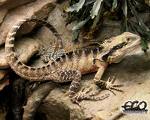
The Australian Water Dragon grows to almost four feet, has a large head, jowl and a spiny crest.
It runs like a dinausor. Sunning or catching insects, it is motionless while waiting.
It hibernates in winter, and re-emerges in spring.
Please use "Back" button to return to haiku.
Haiku #3: by Lorin Ford
First Published: paper wasp , vol 15, no 3, Winter 2009,
Bellbird
The Bellbird, or more correctly, the Bell Miner, is a honeyeater noted for its bell-like musical call.
more information
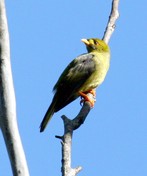
Bell Miner on a branch
Photo: K Vang and W Dabrowka / Bird Explorers
© K Vang and W Dabrowka / Bird Explorers
Please use "Back" button to return to haiku.
Haiku #348: by Nathalie Buckland
First Published: Notes from the Gean, Issue 3, 2009
Please use "Back" button to return to haiku.
Haiku #349: by Ross Clark
First Published: later
Brolga (Grus rubicunda)
A large silver-grey crane noted for its elaborate dance.
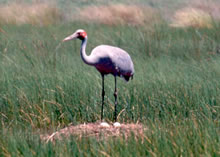
Photo: M Seyfort/Nature Focus
Image courtesy of and © Australian Museum.
Line dancing? See this image of a brolga group. a Bird Explorers picture
Please use "Back" button to return to haiku.
Haiku #350: by Helen Davison
First Published: paper wasp 15 (4) spring 2009
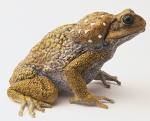
Cane Toads are opportunistic predators and will eat whatever mouth-size prey they can capture.
Although Cane Toads are native to Central and South America, these voracious toads have been introduced to other places around the World,
such as to Australia, in ill-considered attempts to control crop pests.
These huge toads can afford to be rather calm and nonchalant as they hop across the grass because they are quite poisonous.
The large bulge behind the eye is a poison gland. [from 'The firefly Forest']
Please use "Back" button to return to haiku.
Haiku #351: by Helen Davison
First Published: paper wasp 15 (4) spring 2009
Lorikeet
Rainbow Lorikeet
Photos: K Vang and W Dabrowka
/ Bird Explorers
© K Vang and W Dabrowka
Images courtesy of the Australian Museum
For further reading see: Birds in Backyards fact sheet
Please use "Back" button to return to haiku.
Haiku #352: by Ian Iwaszkiewicz
First Published: ???
Please use "Back" button to return to haiku.
Haiku #353: by Lorin Ford
First Published: Paper Wasp, Spring 2008
Please use "Back" button to return to haiku.
Haiku #354: by Lorin Ford
First Published: Stylus , July 2009
Lyrebird
The lyrebird is native to Australia and is noted for its ability to mimic other birds and man-made sounds.
They have a fantastic tail display, like a peacock.
They are ground-dwellers that forage for insects and spiders. They grow up to one metre.
Please use "Back" button to return to haiku.
Haiku #355: by Greg Piko
First Published: The Heron's Nest March 2009
Haiku #356: by Greg Piko
First Published (an earlier version): Blithe Spirit 15(2)
(ferry picture later)
Please use "Back" button to return to haiku.
Haiku #357: by Vanessa Proctor
First Published: Famous Reporter, June 2004

'Northern Australia is a big country shaped by a small insect: the termite.
In many places the very look of northern savannas owes much to the mounds built by colonies of this insect.
North Australian savannas have one of the most diverse range of termite mounds in the world:
from the enormous buttressed “cathedrals” of spinifex termites, to the remarkably aligned “magnetic” mounds and
miniature cities of columns built by various Amitermes species.'
from EnviroNorth - click here for more information
Please use "Back" button to return to haiku.
Haiku #358: by Beverley George
First Published: The Heron's Nest, Vol 11, 2009 - autumn
Please use "Back" button to return to haiku.
Haiku #359: by Timothy K
First Published:
Please use "Back" button to return to haiku.
Haiku #3: by Quendryth Young
First Published: Presence #40, 2009
Please use "Back" button to return to haiku.
Haiku #361: by Max Ryan
First Published: Haiku Dreaming Australia 2010
Cane Toad

Cane Toads are opportunistic predators and will eat whatever mouth-size prey they can capture.
Although Cane Toads are native to Central and South America, these voracious toads have been introduced to other places around the World,
such as to Australia, in ill-considered attempts to control crop pests.
These huge toads can afford to be rather calm and nonchalant as they hop across the grass because they are quite poisonous.
The large bulge behind the eye is a poison gland. [from 'The firefly Forest']
Please use "Back" button to return to haiku.
Haiku #3: by Andrew West
First Published: Haiku Dreaming Australia 2009
Tanami
the poet's image of the Tanami
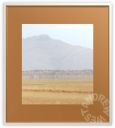
[click to enlarge]
The Tanami Desert is Australia's third largest desert and is located north west of Alice Springs, in the Northern Territory.
It is part of the greater central Australian desert region
Some dry facts: 35% of Australia receives so little rainfall it is classified as desert;
70% of the country is classified as arid or semi-arid (less than 500 mm of rain a year);
That makes Australia the driest inhabited continent on Earth. Only Antarctica is drier;
Only 3% of the Australian population live in those dry 70% of the continent.
[facts from Outback Australia Travel Guide]
Please use "Back" button to return to haiku.
Haiku #363: by Dhugal Lindsay
First Published: Haiku Dreaming Collection, 2010
[This haiku was composed in Japanese and translated into English for this Collection.]
Please use "Back" button to return to haiku.
Haiku #364: by Dhugal Lindsay
First Published: Haiku Dreaming Collection, 2010
[This haiku was composed in Japanese and translated into English for this Collection.]
Please use "Back" button to return to haiku.
Haiku #365: by Lorraine Haig
First Published: The Dreaming Collection, 2010
Please use "Back" button to return to haiku.